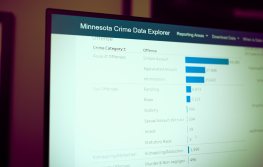Analytics bring the most dangerous sex offenders into the spotlight

Mike Cormaci has a story he likes to tell about a meeting with a MapQuest executive about 20 years ago. It was before smartphones and Google Maps — asking a search engine for “coffee near me” didn’t work yet. MapQuest was the best thing going for location-based data, and even its functionality was limited.
Cormaci shared an idea for a mapping tool and, by his account, the other executive said, “Why would anyone want to look at a bunch of points on a map? People just want to go from A to B.”
Cormaci knew the executive was wrong. He already had a vision for a way to aid law enforcement and provide the public with information that was high in demand. He’s now the co-founder of OffenderWatch — software that helps law enforcement track sex offenders.
It turns out that police love to look at a bunch of points on a map. Today, OffenderWatch is used by about 4,000 law enforcement agencies at all levels of government around the country as a way to stay coordinated and track a segment of society that most people think should be relentlessly monitored, even in an era when personal digital privacy is an otherwise sensitive topic.
The watching is becoming more sophisticated. An analytics extension to OffenderWatch, called FOCUS, now helps law enforcement identify which offenders should be watched most closely. The tool was made widely available last year and is being adopted by law enforcement as a way to more efficiently allocate resources.
For a national law enforcement community that can be overwhelmed by the sex offenders it is entrusted to watch, Cormaci says FOCUS is already surprising police who thought they had a handle on who was the most dangerous.
Check the fridge
The idea of a tool to watch sex offenders was something Cormaci stumbled upon.
While working for a tech company, he attended a California State Sherriffs’ Association meeting, hoping for sales leads. He pitched a map that would display where crimes were being committed, but the sheriffs weren’t interested. One sheriff said there was one thing he was very interested in — the locations of his locality’s sex offenders.
So Cormaci built a database that soon allowed his first client, a law enforcement agency where he lived — in St. Tammany Parish, Louisiana — to update a record online each time a sex offender changed residence. Cormaci wanted to make sure the agency was regularly updating the system, so he set up an email alert for each time a change was made. He was pleased to see numerous updates — in fact, he was receiving so many that he decided to reel it in a little. He changed his email alert to only go off when a sex offender moved within a one mile radius of his office. That’s when he knew he was on to something.
“I said, ‘Man, if this is valuable to me, this would be valuable to everybody,'” Cormaci said.
OffenderWatch is now used by the U.S. Marshals Service, the courts, federal probation and parole agents, prisons, the Department of Defense, the Department of Homeland Security, Immigration and Customs Enforcement, and many local law enforcement agencies. The U.S. Postal Inspection Service uses it to help law enforcement coordinate the location of sex offenders in child pornography distribution cases.
The tool was developed as a way to help government overcome its perennial challenge of many agencies doing the same or similar thing but not communicating with each other. It’s also a public service. Cormaci says there’s one story that illustrates the mission clearly.
“A mother signs up for an email,” he said. “And one day she gets it. It says this new offender has moved in her neighborhood. She prints it out, puts it on her refrigerator. One day, the 6-year-old comes up and says, ‘That’s the candy man.’ The mom goes, ‘The what?’ She says, ‘That’s the candy man. He gives us candy when we get off the school bus.'”
The mother calls the local detective listed in the email. Detectives watch the school bus from an unmarked vehicle the next day, and when the bus pulls away, the kids run to a silver pickup truck that had been following the bus.
“They arrested him right on the spot,” Cormaci said. “So when you hear about this stuff not happening with strangers, it’s true. It’s because they go out and befriend all the children before.”
‘He wasn’t home.’
More commonly, law enforcement finds red flags when it checks up on sex offenders by knocking on their front doors and through regular legally mandated self-reports. The federal Megan’s Law, enacted in 1994, set a national standard for community notification that states model their own registration and community notification laws after.
In 2006, President George W. Bush signed the Adam Walsh Child Protection and Safety Act, establishing a hierarchy for offenders, among other things. Tier 3 sex offenders, the most serious, must update law enforcement on their whereabouts every three months, Tier 2 has to check in every six months, and Tier 1 offenders are required to check in once a year.
An easy guide for sex abuse crimes is to put it in terms of child pornography. Possession is Tier 1. Distribution is Tier 2. Making it is Tier 3. Many agencies use past history as one indicator of future behavior, but that’s rarely the full picture, and charges are not an accurate measure of the offender’s actions. A Tier 1 offender might just be getting started or maybe his charge was pleaded down from a more serious offense. Police need more data to know who’s worth watching.
Some warning signals are easy for law enforcement to interpret. If an offender misses a check-in, that’s typically a sign that someone should find him. But knocking on doors to track people down is inefficient and expensive. Between offenders avoiding police and the low odds that a given person is home at a given hour of the day, it takes an average of more than four visits before an offender is reached this way. It’s more efficient for police to be proactive in maintaining contact with sex offenders and only dedicate time to the highest priority cases.
A study of high-risk sex offenders in California who had been released on parole between January 2006 and March 2009 found that offenders equipped with GPS monitoring devices were far less likely to reoffend. A constant physical reminder that they were being watched was enough to keep most of them honest. But buying, maintaining and managing GPS trackers is expensive, and not practical on a wide scale. There are more than 850,000 sex offenders in the U.S., according to 2016 numbers from the National Center for Missing and Exploited Children. There are more than a million full-time police officers plus many more part-time officers, but police have other jobs than knocking on doors of empty apartments.
Not everyone needs to be watched closely — getting caught once and checking in every so often is enough to keep many from reoffending. But in any jurisdiction’s sex offender population, there are those who need constant reminders. The FOCUS tool was designed to be an administrative workaround to what might otherwise be an insurmountable resource shortage.
It uses predictive analytics to track more than 100 risk factors that paint an image of an offender’s lifestyle. Then it scores offenders on how risky they are — 1 to 10. In addition to using general statistics like census information, the tool uses self-reported metrics like address, relationship status, employment, and vehicle ownership. Police think they already know their offenders and who they should be watching, but that’s proving untrue in pilot testing and early use, Cormaci said.
One tricky thing, he said, is that the factors that point to a risky offender in one area could be totally different than what makes someone risky somewhere else, so OffenderWatch has created customized algorithms for each county. But one factor that remains consistently important, in all cases, Cormaci said, is change. The change could be good or bad, but if an offender’s lifestyle changes by more than 50 percent according to the software’s measurements, that means the person either needs to be watched very closely, or if the changes are positive, he can be removed from close monitoring for the time being.
“Nationally what you typically get is that all of them are treated exactly the same way,” Cormaci said. “Well, you can’t do that when you have 3,000 people [in a single county]. It’s impossible. There’s only 30 days in a month. How many of them can you check up on?”
Finding the bad guys
Instances of an 18- or 19-year-old man who gets in trouble with the law for a relationship with a 16- or 17-year-old girl — known in the law enforcement community as “Romeo and Juliet” cases — may be given similar priority as the neighborhood candy man if an agency isn’t organized. Identifying high-risk targets and checking in with them frequently — a face-to-face version of the nudge that the GPS tracker provided — has produced “astounding” results in early pilots, Cormaci said.
The Baltimore Police Department helped the company develop FOCUS in a pilot between January 2016 and June 2017. Their old system, an “archaic” Lotus Notes database, was in use until 2014, said Detective Sergeant Adam Kirhagis, and it didn’t work well.
“It was garbage in, garbage out — the old cliché,” Kirhagis said. “We had no way to manipulate our data to figure out who are the bad guys. Who are the worst of the worst?”
Kirhagis runs the Sex Offender Registry Unit for the Baltimore Police Department, a criminal investigations team of six. Before that, he ran the child sex abuse unit. Most members of his unit have experience in the child sex abuse unit, he said. He’s been in this line of work for 11 years.
Asked how he does it, he said: “You’d be surprised the discipline you immediately get running these investigations. If your emotions override your intellect, then you’re not going to get decent convictions, the child’s not going to get decent therapy, so you keep a real level head for the greater good.”
FOCUS isn’t a crystal ball, he said, but it is helping them spot “a lot of offenders” they didn’t think were a priority before, amid a list of hundreds of people to track.
“We’re jockeying between 1,300, 1,400 offenders at any time that are on the street,” Kirhagis said.
One offender, whom police asked not be named because his case may be unresolved, is a 74-year-old man with Parkinson’s disease who spends his days sitting in a wheelchair in his apartment in Baltimore. He has a caretaker. His original Tier 3 charge from 1999 was causing abuse to a child. But because of his physical state, he was not considered by Kirhagis’ unit to be a high priority.
“Well, this 80-year old man invited some neighborhood girls in to help clean the house, gave them some money, and then he gave them some more money to…” Kirhagis trailed off. “He reoffended. You’d never think an 80-year old man would be capable of that, but when we ran him through FOCUS, he was a 9 out of 10 on a risk score.”
If Baltimore misread the old man, then there could be others. Cormaci says his company is trying to help police spot these people, because if there’s one thing he’s learned in 20 years of doing this, it’s that the next perpetrator could be anyone.
“They span the socioeconomic scale,” Cormaci said. “It happens in the best neighborhoods. It happens in the worst neighborhoods.”






